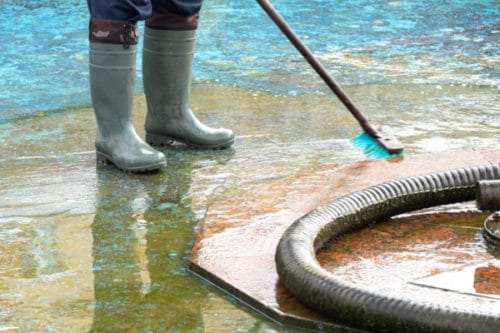Keeping that beautiful water fountain or fancy waterfall clean becomes important once you can smell it from a mile away. Water features need to be cleaned frequently, and an increasingly popular way to do this is by using vinegar.
Vinegar will help with algae, mineral deposits, stains, and water discoloration found in water features. Proper mixing ratios should be used and will not affect your system. It is a great cleansing agent for any fountain and should be added occasionally to help the water stay clean and smell fresh.
Now that we know vinegar is a great option for cleaning, are there any tricks to using it? Are there any situations where you shouldn’t use it?
Why Vinegar
Vinegar has become a popular and commonly used disinfectant and cleaner. It is non-toxic, easily accessible, cheap, and environmentally friendly. You can use it to break down hard water stains that are common on water features, and it can help loosen up or dissolve dirt, grim, grease and algae. It also kills unwanted bacteria beats tough stains.
Vinegar is a common household item, making it a cheap and readily available antibacterial, antiviral, and antiseptic, perfect for killing anything nasty that has been growing in your fountain.
There are several types of vinegar that can be used for cleaning, including white vinegar and apple cider vinegar. For example, white distilled vinegar has a high acid pH balance of 2.4, putting in in between the acid of orange juice and battery acid. Knowing this helps us understand why vinegar is a great option when cleaning a water feature.
How to Clean with Vinegar
There are many ways that vinegar will help to clean out a water fountain or other water feature, you can simply add half a cup of vinegar per gallon of water. You can also empty the fountain, get some vinegar on a rag or brush, and scrub it down. Make sure and do a spot test before you start to ensure that it won’t discolor the fountain.
Depending upon the type of water filtering through your water feature, you may need to adjust how often you clean with vinegar. Hard water will cause more buildup more frequently, requiring you to rinse with vinegar every two weeks. Soft water is not quite as pesky with buildup and can be left for longer periods of time.
While this can be done frequently, it should not be counted as a deep cleaning, and cleaning your pump occasionally would help it to run smoothly and get rid of extra buildup that comes from minerals within the water.
Cleaning Your Pump
Most often, sump pumps are what are used within water features. When wanting to clean this pump, vinegar will be a great option, and can be done relatively easy and quickly.
By itself, vinegar has the potential to ruin or damage your pump, so removing the pump from the sump pit before you start may be the best way to go about it. Once you had done this, pour 1 gallon of vinegar into the sump pit (the hole left when you take the pump out). Let this sit for 15 minutes, eating away the debris and dissolving.
While letting the vinegar do its job, prepare 2 gallons of hot water. Once the vinegar has set for a sufficient amount of time, add in the water, mixing it slightly. Then you can put back in your sump pump and turn it back on, allowing the mixture of water and vinegar to flush through all the pipes and lines.
Other Water Pump Cleaning Methods
While vinegar is a really effective way of cleaning out a water feature and its pump, there are other cleaning methods and preventative measures that can be taken to reduce problems and keep your water feature clean. For example, to prevent a lot of algae from the very beginning, place the fountain in the shade.
If exposed to less light, algae will be less likely to turn your pond into a green mess, although this could have ramifications on any water plants you may be trying to grow intentionally.
Pennies are another interesting tool to keep your water feature algae free. The copper has properties that will poison the algae if the copper content is high enough. While it will not keep all algae from appearing, it will reduce the chance, and is a solid preventative measure.
The very best water to use in your water feature would be distilled water, it comes having already been stripped of the minerals that can often build up and cause problems. Chemicals and buildup that can be avoided by using distilled water are:
- Chlorine
- Lead
- Sodium
- Calcium
- Lithium
- Potassium
Hydrogen Peroxide is also a great alternative cleaning agent for fountains and can be added in to get rid of build-up and algae. Pour in a generous amount, considering the size of your fountain, and then wait a day or so for the water to get clearer.
Bleach also offers another option. Add a cap full to your fountain will do just as the previously mentioned cleaners, but is not natural and can be harmful if birds and other animals are often coming in contact with your water.
Cleaning when You Have Fish
If you have fish in your water feature, they should always be removed before you clean with vinegar. While vinegar is environmentally friendly, it is not something that fish can live in for very long, and can easily kill them. Bleach will also kill your fish and you should never use it in conjunction with anything you are trying to keep alive.
Hydrogen peroxide can be used in very small amounts in fish containers, but when in doubt, always err on the side of caution. Place your fish in a safe, temporary container when you’re cleaning the water feature you normally house them in to keep them safe.

